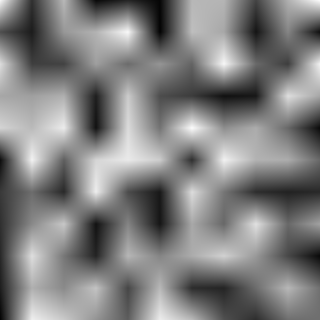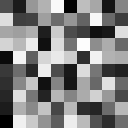Workshop GLSL - Noise - Chapter 5 - Smoothing

Explanations
Pixel noise is cool but we want to smooth it a little.
#define PROCESSING_COLOR_SHADER
uniform float time;
uniform vec2 resolution;
float rand(vec2 co){
return fract(sin(dot(co.xy ,vec2(12.9898,78.233))) * 43758.5453);
}
Our new noise function will fade between all these squares.
float noise(vec2 co, float frequency)
{
vec2 v = vec2(co.x * frequency, co.y * frequency);
float ix1 = floor(v.x);
float iy1 = floor(v.y);
We take adjacent values to interpolate them
float ix2 = floor(v.x + 1.0);
float iy2 = floor(v.y + 1.0);
These are fractional parts, that will use to fade values.
float fx = fract(v.x);
float fy = fract(v.y);
We mix top-left and top-right squares horizontally
float fade1 = mix(rand(vec2(ix1, iy1)), rand(vec2(ix2, iy1)), fx);
We mix bottom-left and bottom-right squares horizontally
float fade2 = mix(rand(vec2(ix1, iy2)), rand(vec2(ix2, iy2)), fx);
And them we mix these vertically to have a nice fade
return mix(fade1, fade2, fy);
}
void main( void ) {
vec2 position = gl_FragCoord.xy / resolution.xy;
float value = noise(position, 10.0);
gl_FragColor = vec4(value, value, value,1.0);
}
Full Code Source
#define PROCESSING_COLOR_SHADER
uniform float time;
uniform vec2 resolution;
float rand(vec2 co){
return fract(sin(dot(co.xy ,vec2(12.9898,78.233))) * 43758.5453);
}
float noise(vec2 co, float frequency)
{
vec2 v = vec2(co.x * frequency, co.y * frequency);
float ix1 = floor(v.x);
float iy1 = floor(v.y);
float ix2 = floor(v.x + 1.0);
float iy2 = floor(v.y + 1.0);
float fx = fract(v.x);
float fy = fract(v.y);
float fade1 = mix(rand(vec2(ix1, iy1)), rand(vec2(ix2, iy1)), fx);
float fade2 = mix(rand(vec2(ix1, iy2)), rand(vec2(ix2, iy2)), fx);
return mix(fade1, fade2, fy);
}
void main( void ) {
vec2 position = gl_FragCoord.xy / resolution.xy;
float value = noise(position, 10.0);
gl_FragColor = vec4(value, value, value,1.0);
}


